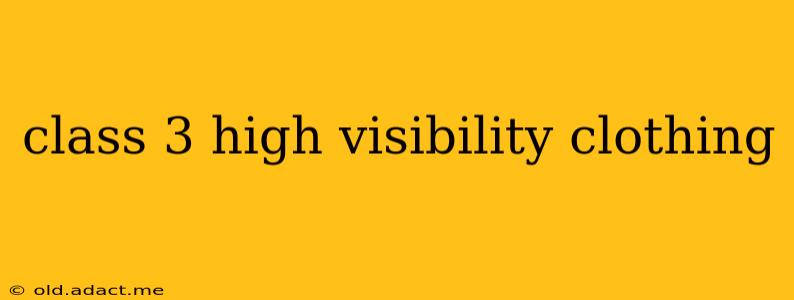High-visibility clothing (HVC) plays a crucial role in ensuring worker safety, particularly in environments with limited visibility or hazardous conditions. Class 3 high-visibility clothing offers the highest level of protection, exceeding the requirements of lower classes. This comprehensive guide will delve into the specifics of Class 3 HVC, addressing common questions and concerns.
What is Class 3 High Visibility Clothing?
Class 3 high-visibility clothing is designed to make the wearer highly visible from all angles, even in challenging lighting conditions. It meets stringent standards set by regulatory bodies like ANSI/ISEA 107 and EN ISO 20471, ensuring maximum protection for workers in high-risk situations. This level of visibility is achieved through the strategic placement and quantity of retroreflective materials and fluorescent background colors. Think construction sites, roadside work, emergency services, and any environment where visibility is paramount for safety.
What are the Key Features of Class 3 High Visibility Apparel?
Class 3 HVC distinguishes itself through several critical features:
- Larger Surface Area of Retroreflective Material: Compared to Class 1 and 2, Class 3 garments incorporate a significantly larger area of retroreflective tape, ensuring visibility from greater distances and wider angles. This is essential for ensuring that workers are seen even in low-light or nighttime conditions.
- Increased Fluorescent Material: Class 3 garments utilize a substantial amount of fluorescent material, providing a bright, noticeable base color during daytime. This acts as the primary means of visibility in well-lit environments. The combination of fluorescent and retroreflective material maximizes visibility under all lighting conditions.
- Specific Garment Design: The design itself is important. Class 3 garments are often designed to ensure full coverage and minimize areas where retroreflective material might be obstructed.
What are the Different Types of Class 3 High Visibility Clothing?
A wide range of garments falls under the Class 3 classification, offering options to suit diverse needs and environments. These include:
- High-Visibility Jackets: Designed for layering or as standalone outerwear, offering excellent protection from the elements.
- High-Visibility Vests: Often worn over other clothing, providing an additional layer of high visibility.
- High-Visibility Trousers/Pants: Critical for lower body protection and visibility.
- High-Visibility Coveralls: Providing full-body coverage and protection.
The choice of garment depends on the specific job and environmental conditions.
Where Can I Find Class 3 High Visibility Clothing?
Class 3 high-visibility clothing is widely available from various occupational safety suppliers and online retailers specializing in personal protective equipment (PPE). Always ensure that the garments you purchase meet the relevant safety standards (ANSI/ISEA 107 or EN ISO 20471) and are certified accordingly. Don't compromise on safety; choose reputable suppliers.
How Often Should Class 3 High Visibility Clothing Be Replaced?
Regular inspection and replacement are critical for maintaining the effectiveness of high-visibility clothing. Garments should be inspected for damage, fading, or wear and tear. Deteriorated retroreflective material significantly reduces its visibility performance. The frequency of replacement depends on the garment’s use and the working environment but should always be aligned with your company's safety policies and relevant standards.
What are the Standards for Class 3 High Visibility Clothing?
Class 3 high-visibility clothing must adhere to the standards set by ANSI/ISEA 107 in North America and EN ISO 20471 in Europe. These standards detail the specific requirements for the amount and placement of retroreflective and fluorescent materials, ensuring a consistent level of protection across different manufacturers. Always look for certification markings that confirm compliance with these standards.
How Much Does Class 3 High Visibility Clothing Cost?
The cost of Class 3 high-visibility clothing varies depending on the garment type, material, brand, and retailer. While higher-quality garments may be more expensive, the investment in worker safety is invaluable. Consider the long-term cost-effectiveness and the protection offered compared to cheaper, potentially substandard alternatives.
This guide provides a foundational understanding of Class 3 high-visibility clothing. Remember to prioritize safety and always consult with safety professionals to ensure appropriate selection and usage for your specific work environment. Investing in high-quality, compliant Class 3 HVC is an investment in the safety and well-being of your workforce.
